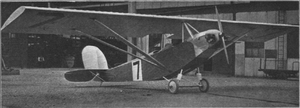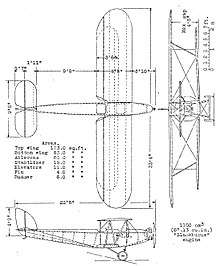Supermarine Sparrow
The Supermarine Sparrow was a British two-seat light aircraft designed by R.J. Mitchell and built by Supermarine at Woolston.
| Sparrow | |
|---|---|
 | |
| Supermarine Sparrow II, marked as number "7" for the 1926 Lympne light aircraft trials | |
| Role | Two-seat light aircraft |
| Manufacturer | Supermarine Aviation Works |
| Designer | R.J. Mitchell |
| First flight | 11 September 1924 |
| Retired | 1930 |
| Number built | 1 |
Development
The Sparrow I was designed and built for the 1924 Lympne light aircraft trials. It was a two-seat biplane powered by a 35 hp (26 kW) Blackburne Thrush piston engine, with dual controls. The Sparrow I (registered G-EBJP) first flew on 11 September 1924.[1] The Thrush, a three-cylinder radial engine proved to be extremely unreliable and the Sparrow was eliminated from the light aircraft trial due to engine failure. In the Grosvenor Trophy Race at Lympne Aerodrome on 14 October 1924, it came fourth with a speed of 62.08 mph (99.91 km/h).[2]
The aircraft was rebuilt for the 1926 Lympne Trials as a parasol monoplane (and redesignated the Sparrow II) and re-engined with a 32 hp (24 kW) Bristol Cherub III engine. During the trials the Sparrow force-landed near Beachy Head on 12 September 1926, again being eliminated from the competition, which was won by the Hawker Cygnet.[3] After use for testing wing sections, the aircraft was sold to the Halton Aero Club,[4] remaining in existence until 1933.[5]
Variants
- Sparrow I
- Blackburne Thrush powered biplane
- Sparrow II
- Sparrow I modified into a monoplane powered by a Bristol Cherub III piston engine.
Specifications (Sparrow I)

Data from British Civil Aircraft since 1919[5]
General characteristics
- Crew: 1
- Length: 22 ft 8 in (6.91 m)
- Wingspan: 33 ft 4 in (10.16 m)
- Height: 7 ft 5 in (2.26 m) [6]
- Wing area: 256 sq ft (23.8 m2) [6]
- Airfoil: root: NACA; tip: NACA [7]
- Empty weight: 215 lb (98 kg)
- Gross weight: 390 lb (177 kg)
- Powerplant: 1 × Blackburne Thrush 3-cylinder air-cooled radila piston engine, 35 hp (26 kW)
- Propellers: 2-bladed fixed-pitch propeller
Performance
- Maximum speed: 116 mph (187 km/h, 101 kn)
- Service ceiling: 3,350 ft (1,020 m)
References
- Andrews and Morgan 1987, p.310.
- Andrews and Morgan 1987, p.312.
- Andrews and Morgan 1987, p.313.
- Andrews and Morgan 1987, p.314-315
- Jackson 1988, p.316.
- Andrews and Morgan 1987, p.315.
- Lednicer, David. "The Incomplete Guide to Airfoil Usage". m-selig.ae.illinois.edu. Retrieved 16 April 2019.
Bibliography
| Wikimedia Commons has media related to Supermarine Sparrow. |
- Andrews, C.F.; Morgan E.B. (1987). Supermarine Aircraft since 1914. London: Putnam. ISBN 0-85177-800-3.
- Jackson, A.J. British Civil Aircraft since 1919:Volume 3. London. Putnam, 1988, ISBN 0-85177-818-6.
- Shelton, John (2008). Schneider Trophy to Spitfire - The Design Career of R.J. Mitchell (Hardback). Sparkford: Hayes Publishing. ISBN 978-1-84425-530-6.